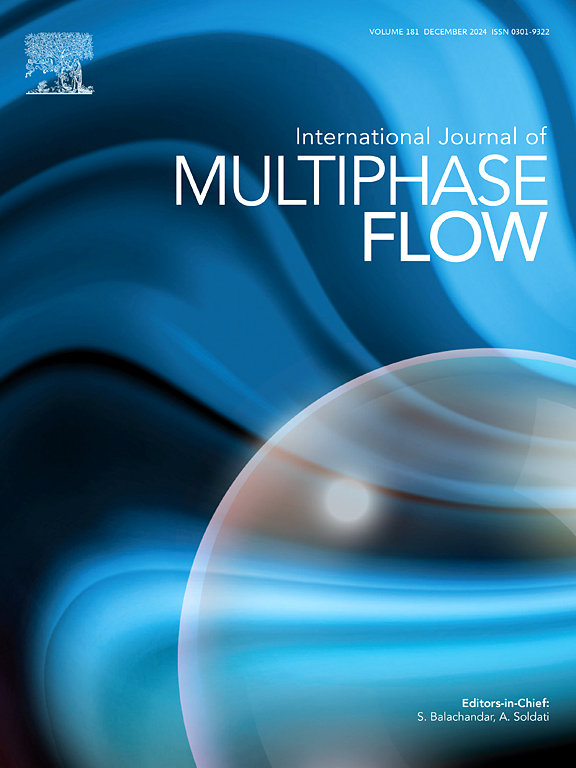液体泡沫通过发散喷嘴的流量测量
IF 3.8
2区 工程技术
Q1 MECHANICS
International Journal of Multiphase Flow
Pub Date : 2025-07-10
DOI:10.1016/j.ijmultiphaseflow.2025.105309
引用次数: 0
摘要
气动泡沫理论描述了泡沫在垂直柱中连续上升的液体输送过程。在一定的横截面积下,假设液体泡沫的运动类似于一个均匀分布的液相塞流。为了评估泡沫通过膨胀流动情况下的气动泡沫理论,我们绘制了液体分数图,并通过光学和x射线成像技术测量了垂直排列发散喷嘴中稳态泡沫流动的局部速度。本文提出并讨论了不同泡沫渗透率模型下的实验结果与理论预测结果的对比。x线照片显示,在名义流动方向上,液体分数随着截面积的增加而减少,这与气动泡沫理论一致,尽管测量到的液体分数总体上高于预测水平。在径向上,液体分数向喷嘴壁面方向略有增加。同样,通过喷嘴内部的x射线粒子跟踪测速技术,结合透明喷嘴壁上的泡沫粒子图像测速技术,可以发现偏离预期塞流的非均匀速度分布。综上所述,液体在喷嘴内的平流输运比气动泡沫理论预测的要低。本文章由计算机程序翻译,如有差异,请以英文原文为准。

Measurement of liquid foam flow through a diverging nozzle
The theory of pneumatic foam describes the transport of liquid by foam rising continuously in a vertical column. At constant cross-sectional area, the liquid foam is assumed to move similar to a plug flow with a uniform distribution of the liquid phase. To assess the pneumatic foam theory in the case of foam flowing through an expansion, we mapped the liquid fraction and measured the local velocity of a steady-state foam flow in a vertically aligned diverging nozzle by means of optical and X-ray imaging techniques. This paper presents and discusses the experimental findings in comparison with the theoretical predictions assuming different models of foam permeability. X-ray radiography revealed that the liquid fraction is decreasing with increasing cross-sectional area in nominal flow direction, which is consistent with the pneumatic foam theory, although the measured liquid fraction was at an overall higher level than predicted. In radial direction, the liquid fraction was found to increase slightly towards the nozzle wall. Similarly, non-uniform velocity profiles that deviate from the expected plug flow were revealed by X-ray particle tracking velocimetry inside the nozzle, combined with foam-adapted particle image velocimetry at the transparent nozzle wall. In conclusion, the advective transport of liquid measured in the nozzle is lower than predicted by the pneumatic foam theory.
求助全文
通过发布文献求助,成功后即可免费获取论文全文。
去求助
来源期刊
CiteScore
7.30
自引率
10.50%
发文量
244
审稿时长
4 months
期刊介绍:
The International Journal of Multiphase Flow publishes analytical, numerical and experimental articles of lasting interest. The scope of the journal includes all aspects of mass, momentum and energy exchange phenomena among different phases such as occur in disperse flows, gas–liquid and liquid–liquid flows, flows in porous media, boiling, granular flows and others.
The journal publishes full papers, brief communications and conference announcements.

 求助内容:
求助内容: 应助结果提醒方式:
应助结果提醒方式:


